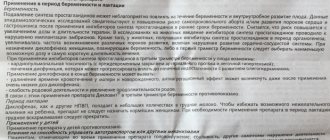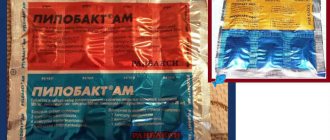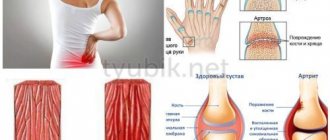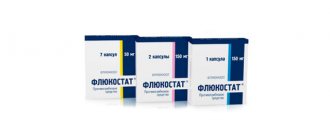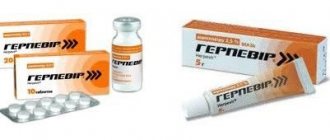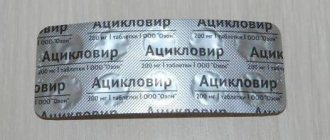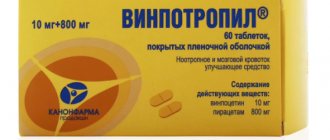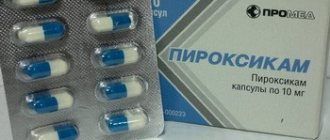Compound
One tablet contains 50 mg of diclofenac + corn starch, povidone, magnesium stearate, hypromellose, yellow iron oxide, methacrylic acid and ethyl acrylate copolymer, lactose monohydrate, microcrystalline cellulose, silicon dioxide, red iron oxide, titanium dioxide, talc, propylene glycol.
Contains suppositories (per suppository): 50 mg of diclofenac sodium + solid fat.
One ampoule of the product contains: 75 mg of diclofenac , benzyl alcohol, sodium disulfite, water, propylene glycol, sodium hydroxide.
Gel for external use contains (in one gram): diclofenac – 10 mg + additional substances (macrogol, isopropanol , anhydrous sodium sulfite, decyl oleate, liquid paraffin, carbomer, diethanolamine, propylene glycol, cetomacrogol).
Release form
The medicine is produced in the form of brown-yellow round tablets. The shape is biconvex, smooth. Each tablet is coated with an enteric film coating. There are 2 packages in cardboard boxes, 10 tablets per package.
The drug is produced in the form of cone-shaped suppositories, white or white with a yellow tint. If you separate the candle, you can see a waxy white or yellowish mass inside. Rectal suppositories are in strips of 5 pieces, 2 strips in a cardboard box.
The solution for intramuscular administration is a clear, colorless or slightly yellowish liquid. The drug is produced in ampoules of 3 ml, 5 ampoules in a blister or plastic tray.
The product is also produced in the form of a white, homogeneous gel, for external use, in aluminum tubes of 60 grams.
Pharmacodynamics and pharmacokinetics
Thanks to the active component of the drug - diclofenac , Naklofen is considered a non-steroidal anti-inflammatory drug . Also an analgesic and antipyretic .
The active substance reduces the intensity of the synthesis of prostacyclin , thromboxane and prostaglandins by inhibiting the activity of the enzymes COX-1 and COX-2 . There is a significant decrease in the level of prostaglandins in the urine, synovial fluid and gastric mucosa.
The drug affects not only the antiprostaglandin phenomenon , but also normalizes increased permeability, microcirculation, and inhibits the activity of mediators of the inflammatory process. The active substance of the drug reduces the overall energy of inflammation and inhibits the process of ATP .
Pain relief occurs due to the ability of the drug to reduce the algogenicity of bradykinin . Diclofenac also reduces the excitability of centers responsible for thermoregulation in certain parts of the diencephalon. Even with prolonged use, the analgesic ability of the drug does not decrease.
40-60 minutes after absorption of the tablets from the gastrointestinal tract , the active substance reaches its maximum in the blood plasma. With intramuscular administration, the maximum is achieved within half an hour, with suppositories - after an hour. After applying the gel for topical use, diclofenac very quickly reaches its target organs, penetrates the muscle tissue, articular cavity, subcutaneous tissue and joint.
If you follow the rules for using the product, it does not accumulate in the body. About 90% of the active substance binds to plasma proteins and penetrates into the synovial fluid and breast milk. the diclofenac that penetrates the body reaches the target organs .
The drug undergoes metabolic . Metabolites are formed using glucuronic acid with the participation of cytochrome P450 enzymes CYP2C9 . The half-life is 2 hours. The drug is excreted through the kidneys in the form of inactive metabolites, with bile and a small amount (about 1%) in unchanged form.
In elderly patients, with kidney or liver diseases, pharmacokinetic parameters remain virtually unchanged.
Naklofen
General instructions
Undesirable effects can be minimized by using the lowest possible effective dose and for the shortest possible course to control (relieve) symptoms. Caution should be exercised in elderly patients. In particular, it is recommended to use the minimum effective dose in frail elderly patients or in patients with low body weight.
Like other NSAIDs, allergic reactions, including anaphylactic/anaphylactoid reactions, may also occur in rare cases with the use of diclofenac without prior use of the drug.
For infectious diseases, it is necessary to take into account the anti-inflammatory and antipyretic effects of diclofenac sodium, since they can mask the symptoms of these diseases.
Concomitant use of Naklofen with other NSAIDs, including selective COX-2 inhibitors, should be avoided due to the lack of evidence demonstrating synergism and possible additive undesirable effects.
Gastrointestinal effects
Gastrointestinal bleeding, ulceration and perforation, which can be fatal, have been reported with all NSAIDs at any time during therapy, with or without warning symptoms, or with or without a history of serious gastrointestinal events. As a rule, they have more serious consequences in older patients. If gastrointestinal bleeding or ulceration occurs in patients receiving diclofenac, its use should be discontinued.
As with other NSAIDs, close medical monitoring and special precautions are required when diclofenac is used in patients with symptoms suggestive of gastrointestinal disturbances or a history of gastric or intestinal ulcers, gastrointestinal bleeding or perforation.
The risk of gastrointestinal bleeding, ulceration or perforation increases with increasing doses of NSAIDs, in patients with a history of ulcers, especially those complicated by bleeding or perforation, and in elderly patients. Elderly patients have an increased incidence of adverse reactions to the use of NSAIDs, especially gastrointestinal bleeding and perforation, which can be fatal.
To reduce the risk of adverse reactions from the gastrointestinal tract in patients with a history of ulcers, especially those complicated by bleeding or perforation, as well as in elderly patients, treatment should begin with the lowest effective dose and maintain this dose in the future.
In such patients, as well as in patients requiring concomitant use of low-dose acetylsalicylic acid or other drugs that increase the risk of gastrointestinal complications, combination therapy with drugs such as misoprostol or proton pump inhibitors should be considered.
Patients with a history of adverse reactions from the gastrointestinal tract, especially the elderly, should report any unusual abdominal symptoms (especially gastrointestinal bleeding), especially at the beginning of treatment. Caution should be exercised in patients concomitantly receiving drugs that increase the risk of ulceration or bleeding, such as systemic corticosteroids, anticoagulants (such as warfarin), selective serotonin reuptake inhibitors, or antiplatelet agents (such as aspirin).
Careful medical monitoring and precautions should be ensured in patients with a history of gastrointestinal diseases (ulcerative colitis, Crohn's disease), since the course of these diseases may be aggravated.
Liver effects
Careful medical supervision is required when prescribing diclofenac to patients with impaired liver function, since the course of this condition may be aggravated.
As with the use of other NSAIDs, the activity values of one or more liver enzymes in the blood plasma may increase during the use of diclofenac. During long-term treatment with diclofenac, regular monitoring of liver function is required as a precaution. If liver function tests persist or worsen, or if clinical signs or symptoms suggestive of liver disease or other manifestations (eg, eosinophilia, skin rash) are present, diclofenac should be discontinued. With the use of diclofenac, hepatitis may develop without prodromal symptoms.
Caution should be exercised when using diclofenac in patients with hepatic porphyria, since its use may provoke an attack of the disease.
Kidney effects
Since fluid retention and edema have been reported during therapy with NSAIDs, including diclofenac, special caution should be exercised when prescribing the drug to patients with impaired cardiac or renal function, a history of hypertension, elderly patients, patients receiving concomitant treatment with diuretics or drugs , which can have a pronounced effect on renal function, as well as in patients with a significant volume of extracellular fluid of various etiologies, for example, before or after major surgery. In these cases, monitoring of renal function is recommended as a precautionary measure during the use of diclofenac. After discontinuation of diclofenac therapy, the patient's condition usually returns to its original state.
Effects on the cardiovascular system and cerebral circulation
Appropriate monitoring and monitoring of patients with arterial hypertension and/or a history of mild or moderate chronic congestive heart failure is required, since fluid retention and edema have been observed during therapy with non-selective NSAIDs.
Results from clinical and epidemiological studies have shown that the use of diclofenac (especially at high doses [150 mg per day] and long-term use) may be associated with a small increased risk of arterial thrombotic events (eg, myocardial infarction or stroke).
Patients with significant risk factors for developing cardiovascular complications (for example, hypertension, hyperlipidemia, diabetes mellitus, smoking) should be prescribed diclofenac only after a careful assessment of the benefit/risk ratio. Since the cardiovascular risks of diclofenac may increase with increasing dose and duration of treatment, diclofenac should be used at the minimum effective dose and for the shortest possible course. The patient's need for therapy and response to treatment should be periodically assessed.
Effects on the skin and subcutaneous tissues
In very rare cases, serious skin reactions, some fatal, including exfoliative dermatitis, Stevens-Johnson syndrome and toxic epidermal necrolysis, have been reported with the use of NSAIDs. Patients are at highest risk for such reactions early in treatment, with most reactions occurring within the first month of treatment. You should stop using the drug Naklofen at the first signs of skin rash, damage to the mucous membranes and other symptoms of hypersensitivity.
Hematological effects
The use of Naklofen is recommended only for short-term treatment. As with the use of other NSAIDs, monitoring of blood test parameters is recommended during long-term therapy with diclofenac.
Like other NSAIDs, diclofenac may temporarily inhibit platelet aggregation. Careful monitoring of the condition of patients with impaired hemostasis should be ensured. Patients with bronchial asthma
In patients with asthma, seasonal allergic rhinitis, swelling of the nasal mucosa (eg, nasal polyps), chronic obstructive pulmonary disease, or chronic respiratory tract infections (especially allergic rhinitis-like symptoms), a reaction to the use of NSAIDs, such as exacerbation of bronchial asthma (so called analgesic intolerance/NSAID-induced asthma [aspirin asthma], angioedema or urticaria are more common than in other patients. Therefore, special care should be taken in such patients (emergency treatment if necessary). This also applies to patients with allergies to other substances, such as skin reactions, itching or urticaria.
Indications for use
Indications for the use of Naklofen are quite varied:
- the medicine is used to alleviate the condition of rheumatism , rheumatoid arthritis , seronegative spondioarthritis ;
- for gout , arthritis and pseudogout ;
- for arthrosis , spondylosis and other degenerative diseases of the spine;
- for the treatment of bursitis , myositis , tendivitis , periarthritis , synovitis ;
- for dysmenorrhea ;
- for the treatment of Permonage-Turner disease ;
- for renal and hepatic colitis .
The medicine is also used for acute migraine pain , during and after dental operations, to relieve pain in oncology , pain after surgery and after injuries ( bruises , sprains, ligament damage ).
The drug is prescribed for infections and inflammations of the ENT organs : otitis media, pharyngitis, tonsillitis , fever .
Naklofen injections are prescribed if the use of another dosage form is not possible.
NACLOFEN Solution for injection 75 mg/3 ml N5
Determination of the frequency of adverse reactions: very often (≥1/10), often (≥1/100,
From the digestive system:
often - abdominal pain, nausea, vomiting, diarrhea, dyspepsia, flatulence, decreased appetite, anorexia, increased aminotransferase activity in the blood serum; rarely - gastritis, gastrointestinal bleeding, vomiting blood, melena, diarrhea mixed with blood, stomach and intestinal ulcers (with or without bleeding or perforation), hepatitis, jaundice, liver dysfunction; very rarely - stomatitis, glossitis, damage to the esophagus, the occurrence of diaphragm-like strictures in the intestine, colitis (nonspecific hemorrhagic colitis, exacerbation of ulcerative colitis or Crohn's disease), constipation, pancreatitis, fulminant hepatitis, liver necrosis, liver failure.
From the nervous system:
often - headache, dizziness; rarely - drowsiness; very rarely - sensory disturbances, including paresthesia, memory disorders, tremors, convulsions, anxiety, acute cerebrovascular accidents, aseptic meningitis; very rarely - disorientation, depression, insomnia, nightmares, irritability, mental disorders.
From the senses:
often - vertigo; very rarely - visual impairment (blurred vision), diplopia, hearing impairment, tinnitus, dysgeusia.
Dermatological reactions:
often - skin rash; rarely - urticaria; very rarely - bullous rashes, eczema, erythema, erythema multiforme, Stevens-Johnson syndrome, Lyell's syndrome (toxic epidermal necrolysis), exfoliative dermatitis, itching, hair loss, photosensitivity reactions; purpura, Henoch-Schönlein purpura.
From the genitourinary system:
very rarely - acute renal failure, hematuria, proteinuria, tubulointerstitial nephritis, nephrotic syndrome, papillary necrosis.
From the hematopoietic system:
very rarely - thrombocytopenia, leukopenia, hemolytic anemia, aplastic anemia, agranulocytosis.
Allergic reactions:
rarely - hypersensitivity, anaphylactic/anaphylactoid reactions, including decreased blood pressure and shock; very rarely - angioedema (including facial swelling).
From the cardiovascular system:
very rarely - palpitations, chest pain, increased blood pressure, vasculitis, heart failure, myocardial infarction. There is evidence of a slight increase in the risk of developing cardiovascular thrombotic complications (for example, myocardial infarction), especially with long-term use of diclofenac in high doses (daily dose more than 150 mg).
From the respiratory system:
rarely - asthma (including shortness of breath); very rarely - pneumonitis.
General reactions:
rarely - swelling.
Contraindications
The medicine is contraindicated:
- if you are allergic to diclofenac or other NSAIDs ;
- in the last trimester of pregnancy ;
- for stomach and duodenal ulcers (for oral forms);
- for bronchial asthma ;
- in the presence of destructive and inflammatory bowel diseases (tablets and suppositories);
- period after coronary artery bypass surgery ;
- bleeding disorders;
- children under 6 years old.
Please be careful:
- with ischemic heart disease ;
- hyperlipidemia and dyslipidemia ;
- for diabetes mellitus ;
- in the 1st and 2nd trimester of pregnancy;
- smokers and frequent alcohol drinkers.
Pharmacological properties of the drug Naklofen
Diclofenac ([o-(2,6 dichloroanilino)phenyl]acetate sodium salt) is an NSAID with pronounced anti-inflammatory, analgesic and antipyretic effects. The mechanism of action is associated with the inhibition of COX and the resulting disruption of prostaglandin synthesis. By blocking the synthesis of prostaglandins, diclofenac eliminates or significantly reduces the severity of symptoms of inflammation. Diclofenac reduces prostaglandin-induced increased sensitivity of nerve endings to mechanical stimuli and biologically active substances that are formed at the site of inflammation. Helps lower body temperature, preventing the effect of prostaglandins on the hypothalamic region of the thermoregulation process, reduces the concentration of prostaglandins in menstrual blood and the intensity of pain during primary dysmenorrhea. During treatment with diclofenac, the concentration of prostaglandins in the urine, gastric mucosa and synovial fluid decreases. During the treatment of rheumatoid arthritis, the drug intensively penetrates into the joint cavity, reduces pain at rest and during movement, helps to increase the range of motion in the affected joints, and reduces morning stiffness and swelling of the joints. Naklofen is used to treat rheumatic diseases; to eliminate pain of any localization of various origins. The tablets are coated with an acid-resistant coating and dissolve after entering the intestines. Naklofen Duo contains diclofenac in the form of granules that are resistant to the action of gastric juice and prolonged-release granules, as a result of which the capsules have both rapid and prolonged action. Retard tablets are intended for long-term treatment. After oral administration, diclofenac sodium is rapidly absorbed in the duodenum and small intestine. Over 90% of the drug is absorbed, but due to metabolism during the initial passage through the liver, bioavailability is about 60%. About 99% of diclofenac binds to plasma proteins, mainly albumin. The half-life is 1–2 hours. More than 70% of diclofenac is excreted in the urine in the form of biologically inactive metabolites, only 1% is excreted unchanged. Diclofenac easily penetrates into the synovial fluid, where its concentration reaches 60–70% of the level in the blood serum. After 3–6 hours, the concentration of the drug and its metabolites in the synovial fluid is higher than in the blood serum. Diclofenac is eliminated from synovial fluid much more slowly than from blood serum.
Side effects
Adverse reactions may occur when taking the drug:
- epigastric pain , vomiting, diarrhea and nausea, anorexia , increased levels of liver enzymes;
- gastritis , exacerbation of hemorrhoids , ulcers on the gastric mucosa, jaundice ;
- dry mouth and mucous membranes, stomatitis , pancreatitis ;
- drowsiness , dizziness and headache , paresthesia , convulsions, tremor , irritability;
- vertigo , hearing, vision, taste disorders;
- hematuria , renal failure;
- leukopenia , thrombocytopenia , agranulocytosis , anemia ;
- anaphylactic shock , decreased blood pressure , increased blood pressure , vasculitis , palpitations;
- cough , shortness of breath , pneumonia ;
- Steven-Johnson syndrome , hair loss, urticaria , itching .
The injection solution may cause irritation and pain at the injection site, pain, swelling and redness.
The gel rarely causes adverse reactions. Photosensitivity , itching, peeling and swelling on the treated surface may occur During and after application, a burning sensation, urticaria , eczema , and anaphylactic reactions .
Naklofen – tablets, capsules, solution, suppositories, tablets
From the digestive organs. More often than 1% - abdominal pain or spasm, bloating, diarrhea, dyspepsia, nausea, constipation, flatulence, increased activity of liver transaminases, peptic ulcer, incl. with complications (perforation, bleeding), gastrointestinal bleeding without ulcer.
Less often than 1% - vomiting, jaundice, melena, blood in the stool, damage to the esophagus, aphthous stomatitis, dry mucous membranes (including the oral cavity), hepatitis, hepatonecrosis, cirrhosis, hepatorenal syndrome, changes in appetite, pancreatitis (including .ch. with concomitant hepatitis), colitis.
From the nervous system. More often than 1% - headache, dizziness.
Less often than 1% - sleep disturbance, drowsiness, depression, diplopia, anxiety, irritability, aseptic meningitis, convulsions, weakness.
From the senses. More often than 1% - tinnitus.
Less often than 1% - blurred visual perception, taste disturbance, hearing loss (including irreversible), scotoma.
From the side of the skin. More often than 1% - skin rash, itchy skin.
Less commonly 1% - alopecia, urticaria, eczema, toxic dermatitis, exudative erythema multiforme (including Stevens-Johnson syndrome), toxic epidermal necrolysis (Lyell's syndrome), photosensitivity.
From the genitourinary system. More often than 1% is fluid retention.
Less often than 1% - nephrotic syndrome, proteinuria, oliguria, interstitial nephritis, papillary necrosis, acute renal failure, azotemia.
From the hematopoietic organs. Less often than 1% - anemia (including hemolytic and aplastic), leukopenia, thrombocytopenia, eosinophilia, agranulocytosis, thrombocytopenic purpura.
From the respiratory system. Less often than 1% - cough, bronchospasm, laryngeal edema.
From the SSS side. Less often than 1% - increased blood pressure, congestive heart failure.
Allergic reactions. Less often than 1% - swelling of the lips and tongue, anaphylactoid reactions, anaphylactic shock (usually develops rapidly). Overdose. Symptoms: dizziness, headache, hyperventilation, clouding of consciousness, in children - myoclonic convulsions, nausea, vomiting, abdominal pain, bleeding, impaired liver and kidney function.
Treatment: gastric lavage, activated charcoal, symptomatic therapy aimed at eliminating increased blood pressure, renal dysfunction, convulsions, gastrointestinal irritation, respiratory depression. Forced diuresis and hemodialysis are ineffective.
Naklofen, instructions for use (Method and dosage)
The duration of administration, dosage form and dosage should be determined by the attending physician.
Use of tablets
The tablets are taken orally, after or during meals, without splitting or chewing.
Patients whose weight exceeds 45 kg are prescribed 50 mg of the drug twice or three times a day. After achieving the desired effect, it is recommended to gradually reduce the dose. The maximum amount of diclofenac taken per day is 150 mg.
Instructions for suppositories
The suppositories are administered rectally. The initial daily dosage for adults is 100 mg, the maximum is 150 mg. At the age of 15 to 18 years, it is recommended to administer no more than 2 suppositories per day.
Naklofen injections, instructions for use
Injections are performed exclusively intramuscularly. The maximum amount of medication at one time is 75 mg, after 12 hours the next dose can be administered.
The exception is patients with renal colic ; they can be given 2 injections, with an interval of half an hour.
If other drugs containing diclofenac , you should remember the maximum permissible daily dosage (150 mg).
Do not mix Naklofen with other medications in ampoules in the same syringe.
Application of the gel
The gel is applied to the affected part of the body and gently rubbed into the skin, 2 or 3 times a day, no more than 10 cm of gel. The course of treatment should not exceed 10 days.
For children from 6 to 12, the applied strip is no longer than 3 cm, the frequency of application is no more than 2 times a day.
Use of the drug Naklofen
For adults with acute pain syndrome, Naklofen is prescribed 3 ml of solution intramuscularly (contents of 1 ampoule) 1–2 times a day for a short time, followed by switching to oral administration or rectal administration of the drug. For patients with pain syndrome due to renal colic, a second injection at a dose of 75 mg can be prescribed 30 minutes after the first. Parenteral administration of the drug to children is not recommended. The tablets are taken orally during or after meals without chewing, with a small amount of water. Adults are prescribed an initial dose of 100–150 mg/day, depending on the severity of the disease; the usual maintenance dose is 100 mg/day. Children over 14 years of age are prescribed a daily dose of 100 mg, which must be divided into 2 doses. If taking Naklofen tablets is combined with the use of other dosage forms, the total daily dose of the drug should be taken into account. The daily dose of diclofenac is 150 mg and depends on the severity of the disease. At the beginning of treatment, 1 capsule of Naklofen Duo is prescribed 1-2 times a day. In case of severe symptoms, especially in the morning, the daily dose (2 capsules) can be taken in one dose or after a short period of time. Maintenance dose - 1 capsule per day. If taking Naklofen Duo capsules is combined with its other pharmaceutical forms, the total daily dose of the drug should be taken into account, which should not exceed 150 mg. Capsules should be swallowed whole with a small amount of liquid during or immediately after meals. Retard tablets are prescribed 1 tablet per day. For patients who do not tolerate oral administration of the drug, it can be prescribed in suppository form. The initial dose is 100–150 mg/day, usually 1 rectal suppository of 50 mg 2–3 times a day. The usual maintenance dose is 1 suppository of 50 mg 2 times a day. Suppositories are not indicated for use in children.
Interaction
The concentration of digoxin lithium drugs , cyclosporine and methotrexate may increase significantly under the influence of the drug.
The effect of antihypertensive and hypnotics is reduced when combined with the drug.
The drug reduces the effectiveness of hypoglycemic drugs .
The medicine increases the toxicity of glucocorticosteroids and Paracetamol .
Concurrent use of acetylsalicylic acid reduces the effectiveness of diclofenac .
Use caution when combining the drug with
- Cefamandole , Cefotetan , Plicamycin , Cefoperazone and Valproic acid ;
- selective serotonin reuptake inhibitors, ethanol, Corticotropin , St. John's wort , Colchicine due to an increased risk of bleeding;
- drugs that cause hypersensitivity to light;
- blockers of tubular secretion;
- antibacterial drugs of the quinolone .
When the drug is combined with cyclosporine and gold preparations, their nephrotoxicity increases.
Do not mix diclofenac and other drugs in the same syringe.
Drug interactions Naklofen
Simultaneous administration of Naklofen with lithium salts or digoxin may cause an increase in their concentration in the blood serum. Naklofen may reduce the diuretic effect of some diuretics; its simultaneous administration with potassium-sparing diuretics can lead to the development of hyperkalemia. When administered simultaneously with acetylsalicylic acid or other NSAIDs, the risk of side effects increases. May enhance the nephrotoxic effect of cyclosporine and the toxic effects of methotrexate, reduce the effectiveness of antihypertensive drugs. Diclofenac generally does not affect the activity of oral hypoglycemic agents.
special instructions
If the drug is taken for more than 2 weeks, monitoring of liver enzyme .
If there are signs of liver disease, you should stop taking the drug and consult a specialist.
While taking the medication, an exacerbation of existing diseases in the anamnesis is possible.
Taking the drug may adversely affect female fertility .
For elderly patients, it is important to select the minimum active and effective dosage.
When taking the drug (all dosage forms except the gel), you should avoid driving a car and other processes that require high concentration and reaction speed.
Do not apply the gel under occlusive dressings , on open wounds or damaged skin.
After using the gel, you should wash your hands thoroughly and avoid contact of the drug with the eyes and mucous membranes, and avoid exposure to direct sunlight.
Naklofen
Special conditions
During treatment, gastrointestinal bleeding may occur at any time or a gastrointestinal ulcer may develop, which is sometimes complicated by perforation. The risk of bleeding in the digestive tract increases with increasing dose and in patients with a history of ulcers. These complications are not necessarily preceded by warning symptoms or a history of ulcers. More severe consequences are observed in elderly patients. To reduce the risk of such gastrointestinal toxicity, treatment is initiated and maintained at the lowest effective dose. For such patients, as well as those requiring concomitant use of medicinal products containing low doses of acetylsalicylic acid or other medicinal products thought to increase the risk of adverse gastrointestinal effects, combination therapy with protective agents (e.g. proton-containing inhibitors) should be considered. pump or misoprostol). In those rare cases when patients receiving the drug develop these complications, it should be discontinued. In patients who have not previously taken diclofenac sodium, while taking this drug, as with treatment with other NSAIDs, allergic reactions, including anaphylactic and anaphylactoid, may in some cases develop. Due to its pharmacodynamic properties, Naklofen, like other NSAIDs, can mask signs and symptoms characteristic of infections. While taking the drug, careful medical monitoring is necessary for patients with symptoms indicating gastrointestinal diseases or a history of ulcers, patients with ulcerative colitis or Crohn's disease, as well as patients with impaired liver function. As with other NSAIDs, the levels of one or more liver enzymes may increase. Therefore, during long-term therapy with diclofenac, regular liver function testing is indicated as a precautionary measure. If abnormalities in liver function parameters persist or worsen, if signs or symptoms indicating liver disease develop, or if other side effects occur (for example, eosinophilia, rashes, etc.), the drug should be discontinued. Hepatitis when taking the drug can occur without prodromal phenomena. Caution is necessary when prescribing diclofenac sodium to patients with hepatic porphyria, since the drug can provoke attacks of porphyria. Since prostaglandins play an important role in maintaining renal blood flow, special caution is required when treating diclofenac in patients with impaired cardiac or renal function, elderly patients, patients receiving diuretics, as well as patients who have a significant decrease in circulating plasma volume of any etiology, for example before and after massive surgical interventions. In such cases, regular monitoring of renal function is recommended as a precautionary measure during use of the drug. After discontinuation of the drug, the function
Analogs
Level 4 ATC code matches:
Voltaren
Rapten
Zerodol
Dickloberl Retard
Dikloberl N 75
Dicloberl
Ketanov
Dolak
Panoxen
Ketorolac
Naklofen Duo
Olfen-100
Olfen-75
Neurodiclovit
Nizilat
Fanigan
Aertal
Ortofen
Flamidez
The most common analogues: Diclak, Diclofenac, Voltaren, Rapten, Naklofen Duo, Almiral, Diclobrew, Dicloberl, Dicloreum, Olfen, Indomethacin , Fanigan Fast, Feloran, Fastum gel, Nise, Dolgit, Dolaren, Flamidez, Ketorol, Ketonal.
Naklofen price, where to buy
The price of Naklofen tablets is approximately 100 rubles for 20 pieces.
The cost of rectal suppositories is 70 rubles for 10 pieces.
The price of Naklofen in the form of an injection solution is 47 rubles for 5 ampoules of 3 ml.
Gel for topical use can be purchased for 200 rubles (60 grams).
- Online pharmacies in RussiaRussia
- Online pharmacies in UkraineUkraine
- Online pharmacies in KazakhstanKazakhstan
ZdravCity
- Naklofen duo capsules with mod.
release 75 mg 20 pcs. JSC KRKA, d.d., Novo mesto 102 rub. order
Pharmacy Dialogue
- Naklofen DUO MV (caps. 75 mg No. 20)KPKA
117 RUR order
show more
Pharmacy24
- Naklofen 50 mg N10 suppositories KRKA, Slovenia
91 UAH. order - Naklofen 75 mg/3 ml N5 solution KPKA, d.d., Novo Mesto, Slovenia
109 UAH order
- Naklofen 50 mg No. 20 tablets KRKA, Slovenia
95 UAH order
- Naklofen DUO 75 mg No. 20 capsules KRKA, Slovenia
115 UAH order
- Naklofen retard 100 mg No. 20 tablets KRKA, Slovenia
109 UAH order
PaniPharmacy
- Naklofen retard tablets Naklofen retard tablets. 100 mg No. 20 Slovenia, KRKA dd Novo Mesto
139 UAH. order
- Naklofen tablets Naklofen tablets. 50 mg No. 20 Slovenia, KRKA dd Novo Mesto
98 UAH order
- Naklofen ampoule Naklofen solution d/in. 75mg amp. 3ml No. 5 Slovenia, KRKA dd Novo Mesto
121 UAH order
- Naklofen duo capsule Naklofen duo caps. 75 mg No. 20 Slovenia, KRKA dd Novo Mesto
134 UAH order
- Naklofen suppository Supp. naklofen 50 mg No. 10 Slovenia, KRKA dd Novo Mesto
107 UAH order
show more

